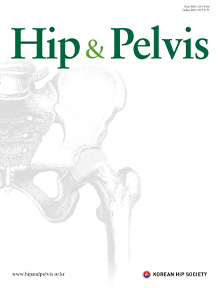Quick links
Related article in
-
Original ArticleJune 30, 2020
 0
0
 89
89
 30
30

Early Experience of Direct Anterior Approach Total Hip Arthroplasty: Analysis of the First 53 Cases
Chung-Young Kim, MD, Young-Yool Chung, MD
Hip Pelvis 2020; 32(2): 78-84 , Seung-Woo Shim, MD, Sung-Nyun Baek, MD, Cheol-Hwan Kim, MDAbstractPurpose: To determine if it is feasible and safe for a surgeon to transition from using the posterolateral approach to direct anterior approach (DAA) by evaluating the first 53 cases of total hip arthroplasty using a DAA.
, Seung-Woo Shim, MD, Sung-Nyun Baek, MD, Cheol-Hwan Kim, MDAbstractPurpose: To determine if it is feasible and safe for a surgeon to transition from using the posterolateral approach to direct anterior approach (DAA) by evaluating the first 53 cases of total hip arthroplasty using a DAA.
Materials and Methods: A retrospective review of 52 patients who underwent THA using a DAA between July 2017 and December 2018. Reasons for THA were: femoral neck fracture (n=34), avascular necrosis (n=13), and arthritis (n=6). The mean age was 70 years old. An assessment of feasibility was made by analyzing mean operative time and blood loss. Cup inclination, anteversion, and leg length discrepancy (LLD) were measured using postoperative radiology. Safety of the DAA was judged using the incidence and nature of all complications.
Results: The mean operative time was 112 minutes. 135 minutes for the 1st 10 cases, 100 minutes for 2nd 10 cases, 113 minutes for 3rd 10 cases, 119 minutes for 4th 10 cases, and 91 minutes for the final 13 cases. The mean blood loss was 724 mL. Average cup inclination was 40.27°; 2 cases were out of safety angle. Mean anteversion was 16.18°. No intraoperative fractures or infections were observed. LLD was detected in 3 cases, one of which underwent revision due to walking difficulty. Dislocation occurred in 3 cases, all within the first 20 cases, however, there was no recurrent dislocation.
Conclusion: DAA for THA was deemed to be feasible and safe based on an assessment of operative time, blood loss and complications. -
Review ArticleDecember 1, 2011
 0
0
 61
61
 12
12
Fixing Leg Length Discrepancies after Total Hip Arthroplasty
Young Wook Lim, MD, Bum Yong Park, MD, Yong Sik Kim, MD
J Korean Hip Soc 2011; 23(4): 258-261Leg length discrepancies are a common cause of patient dissatisfaction after total hip arthroplasty (THA). The equalization of limb lengths and restoration of the anatomic geometry of the hip to restore normal gait and function are the primary goals during THA. Patients recognize a leg length discrepancy when one leg is shorter than the other by 6 mm or longer than the other by 10 mm after THA. Outside of this range, several problems would occur. Therefore, we should try to maintain leg length during THA via preoperative and intra-operative planning. -
Original ArticleDecember 31, 2023
 0
0
 197
197
 42
42

A Comparative Study of Bipolar Hemiarthroplasty for Intertrochanteric Fracture: Direct Anterior Approach versus Conventional Posterolateral Approach
Young Yool Chung, MD
Hip Pelvis 2023; 35(4): 246-252 , Seung-Woo Shim, MD
, Seung-Woo Shim, MD  , Min Young Kim, MD
, Min Young Kim, MD  , Young-Jae Kim, MD
, Young-Jae Kim, MD  AbstractPurpose: The aim of this study was to compare short-term results from use of the direct anterior approach (DAA) and the conventional posterolateral approach (PLA) in performance of bipolar hemiarthroplasty for treatment of femoral intertrochanteric fractures in elderly patients.
AbstractPurpose: The aim of this study was to compare short-term results from use of the direct anterior approach (DAA) and the conventional posterolateral approach (PLA) in performance of bipolar hemiarthroplasty for treatment of femoral intertrochanteric fractures in elderly patients.
Materials and Methods: A retrospective review of 100 patients with intertrochanteric fractures who underwent bipolar hemiarthroplasty was conducted. The PLA was used in 50 cases from 2016 to 2019; since that time we have used the DAA in 50 cases from 2019 to 2021. Measurements of mean operative time, blood loss, hospitalization period, and ambulation status, greater trochanter (GT) migration and stem subsidence were performed. And the incidence of complications was examined.
Results: Operative time was 73.60±14.56 minutes in the PLA group and 79.80±8.89 minutes in the DAA group (P<0.05). However, after experiencing 20 cases using DAA, there was no statistically difference in operative time between two groups (P=0.331). Blood loss was 380.76±180.67 mL in the PLA group and 318.14±138.51 mL in the DAA group (P<0.05). The hospitalization was 23.76±11.89 days in the PLA group and 21.45 ±4.18 days in the DAA group (P=0.207). In both groups, there were no progressive GT migration, intraoperative fractures or dislocations, although there was one case of infection in the PLA group.
Conclusion: Although use of the DAA in performance of bipolar hemiarthroplasty required slightly more time in the beginning compared with the PLA, the DAA may well be an alternative, safe surgical technique as a muscle preserving procedure in elderly patients with intertrochanteric fractures. -
Review ArticleMarch 1, 2024
 0
0
 840
840
 251
251

Pathophysiology and Treatment of Gout Arthritis; including Gout Arthritis of Hip Joint: A Literature Review
Yonghan Cha, MD
Hip Pelvis 2024; 36(1): 1-11 , Jongwon Lee, MD
, Jongwon Lee, MD  , Wonsik Choy, MD
, Wonsik Choy, MD  , Jae Sun Lee, PhD*,†
, Jae Sun Lee, PhD*,†  , Hyun Hee Lee, MD‡
, Hyun Hee Lee, MD‡  , Dong-Sik Chae, MD‡
, Dong-Sik Chae, MD‡  AbstractGout is triggered by the accumulation of uric acid in the body, leading to hyperuricemia. Genetic, metabolic, and environmental factors can influence this condition. Excessive uric acid buildup results in the formation of monosodium urate (MSU) crystals, which precipitate in specific areas of the body, including the joints, where they can cause symptoms of gout. While the acute and chronic symptoms of gout have been well-documented, diagnosis of gout affecting the hip joint poses significant challenges. The global incidence of gout, the most prevalent form of inflammatory arthritis, is on the rise. Evaluation of the clinical signs, laboratory results, and imaging results is generally required for diagnosis of gout in cases where MSU crystals have not been detected. Hyperuricemia is considered a primary cause of arthritis symptoms, and comprehensive guidelines for treatment are available. Therefore, the choice of medication is straightforward, and moderate effectiveness of treatment has been demonstrated. Gout is a chronic disease, requiring lifelong uric acid-lowering medications, thus application of a treatment strategy based on the target blood uric acid concentration is necessary. Consequently, cases of gout will likely be observed more frequently by hip surgeons in clinical scenarios in the future. The objective of this review is to provide an overview of the pathophysiology of gout and subsequently examine recent advances in diagnostic methods and therapeutic agents based on an understanding of its underlying mechanisms. In addition, literature on gout-related issues affecting the hip joint, providing a useful reference for hip surgeons is examined.
AbstractGout is triggered by the accumulation of uric acid in the body, leading to hyperuricemia. Genetic, metabolic, and environmental factors can influence this condition. Excessive uric acid buildup results in the formation of monosodium urate (MSU) crystals, which precipitate in specific areas of the body, including the joints, where they can cause symptoms of gout. While the acute and chronic symptoms of gout have been well-documented, diagnosis of gout affecting the hip joint poses significant challenges. The global incidence of gout, the most prevalent form of inflammatory arthritis, is on the rise. Evaluation of the clinical signs, laboratory results, and imaging results is generally required for diagnosis of gout in cases where MSU crystals have not been detected. Hyperuricemia is considered a primary cause of arthritis symptoms, and comprehensive guidelines for treatment are available. Therefore, the choice of medication is straightforward, and moderate effectiveness of treatment has been demonstrated. Gout is a chronic disease, requiring lifelong uric acid-lowering medications, thus application of a treatment strategy based on the target blood uric acid concentration is necessary. Consequently, cases of gout will likely be observed more frequently by hip surgeons in clinical scenarios in the future. The objective of this review is to provide an overview of the pathophysiology of gout and subsequently examine recent advances in diagnostic methods and therapeutic agents based on an understanding of its underlying mechanisms. In addition, literature on gout-related issues affecting the hip joint, providing a useful reference for hip surgeons is examined.
- 1

Vol.36 No.1
Mar 01, 2024, pp. 1~75
Most Keyword
?
What is Most Keyword?
- It is most registrated keyword in articles at this journal during for 2 years.
Most View
-
Pathophysiology and Treatment of Gout Arthritis; including Gout Arthritis of Hip Joint: A Literature Review
Yonghan Cha, MD
Hip Pelvis 2024; 36(1): 1-11 , Jongwon Lee, MD
, Jongwon Lee, MD  , Wonsik Choy, MD
, Wonsik Choy, MD  , Jae Sun Lee, PhD*,†
, Jae Sun Lee, PhD*,†  , Hyun Hee Lee, MD‡
, Hyun Hee Lee, MD‡  , Dong-Sik Chae, MD‡
, Dong-Sik Chae, MD‡ 
-
Treatment of Osteoporosis after Hip Fracture: Survey of the Korean Hip Society
Jung-Wee Park, MD
Hip Pelvis 2024; 36(1): 62-69 , Je-Hyun Yoo, MD*
, Je-Hyun Yoo, MD*  , Young-Kyun Lee, MD
, Young-Kyun Lee, MD  , Jong-Seok Park, MD†
, Jong-Seok Park, MD†  , Ye-Yeon Won, MD‡
, Ye-Yeon Won, MD‡ 
Editorial Office
Laboratory tests performed in hip fracture patients. CTX: carboxy-terminal telopeptide of collagen I, PTH: parathyroid hormone, P1NP: procollagen type I N propeptide, U/A: urinalysis.|@|~(^,^)~|@|First-line treatment option for osteoporosis in hip fracture patients. BP: bisphosphonate, PTH: parathyroid hormone, SERM: selective estrogen receptor modulator.|@|~(^,^)~|@|Osteoporosis medication in patients with rebound phenomenon after cessation of denosumab. Ca+Vit. D: calcium and vitamin D, PTH: parathyroid hormone, SERM: selective estrogen receptor modulator.|@|~(^,^)~|@|The most important recognized factor for atypical femoral fracture.|@|~(^,^)~|@|Preferred osteoporosis medications after cessation of bisphosphonate in patients with atypical femoral fracture. PTH: parathyroid hormone, Ca+Vit. D: calcium and vitamin D, SERM: selective estrogen receptor modulator.|@|~(^,^)~|@|Preferred osteoporosis medications in patients with high-risk of atypical femoral fracture. Ca+Vit. D: calcium and vitamin D, SERM: selective estrogen receptor modulator, PTH: parathyroid hormone.
Hip Pelvis 2024;36:62~69 https://doi.org/10.5371/hp.2024.36.1.62
© H&P
© 2024. The Korean Hip Society. Powered by INFOrang Co., Ltd




 Cite
Cite PDF
PDF



